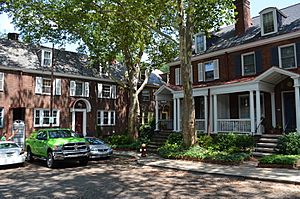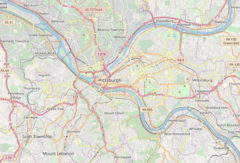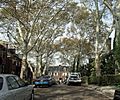Roslyn Place (district) facts for kids
 |
|
| Location | 506-523 & 525 Roslyn Place (Shadyside (Pittsburgh)), Pittsburgh, Pennsylvania, USA |
|---|---|
| Coordinates | 40°27′12.74″N 79°56′9.94″W / 40.4535389°N 79.9360944°W |
| Built/founded | 1914-1917 |
| Architect | Thomas Rodd |
| Governing body/ |
Numerous Private Owners |
| CPHD designated | March 20, 2018 |
| PHLF designated | 2000 |
Roslyn Place is a special group of homes in the Shadyside neighborhood of Pittsburgh, Pennsylvania. These houses were built a long time ago, between 1914 and 1917. They were designed in two classic styles: Colonial Revival and Georgian Revival. Today, families still live in these beautiful homes.
Contents
Discovering Roslyn Place's Past
Before Roslyn Place was built, this land was owned by J.W. Friday. It had just one wooden house and a few small wooden buildings. By 1904, a man named Thomas Rodd owned the property. His family lived on the land next door.
Who Was Thomas Rodd?
Thomas Rodd was born in London, England. He moved to the United States when he was five years old. He served in the Navy during the American Civil War. After the war, he became an engineer for the Pennsylvania Railroad Company. In 1889, he became the chief engineer for all lines west of Pittsburgh. This is when he moved to Pittsburgh.
The Rodd family became very important in Pittsburgh's social scene. Thomas Rodd was a member of many famous clubs, like the Duquesne Club and the Pittsburgh Golf Club. His family's trips were even reported in newspapers!
Building Roslyn Place
Thomas Rodd was not only an engineer but also a designer. He was in charge of building many structures in western Pennsylvania and the Midwest. He also designed and built Roslyn Place. He even designed the unique street that the houses sit on, which is also called Roslyn Place.
Construction started in 1914 after the City Council approved his plans. They also approved a water pipe line for the new area, showing how modern the development was. Building continued for two more years, finishing in 1917. Advertisements for the new homes were then published.
For many years, the Rodd family rented out these homes. It wasn't until the 1950s that the individual houses were sold. People still live in them today. In 2017, Roslyn Place was suggested to become a City Historic District by Preservation Pittsburgh. This means it's a special place worth protecting.
The Architecture of Roslyn Place
Thomas Rodd designed Roslyn Place in the Colonial Revival style. It also has strong influences from the Georgian Revival style. These styles are not very common in Pittsburgh, which makes Roslyn Place unique.
Colonial and Georgian Styles
The homes at Roslyn Place are special because of their size, how uniform they look, and their high-quality design. You can see Georgian Revival elements in the buildings. Look for things like:
- Symmetrical fronts (meaning both sides look the same).
- Round hoods over doors.
- Triangular shapes (pediments) over porches.
- The use of brick as a main building material.
- Patterned designs (coffered elements) on porches and hoods.
A Special Street
The street itself, Roslyn Place, is also famous. It's an example of Nicolson pavement, a type of wooden block street. The way the neighborhood was designed and planned is well-known. Even famous urban planners like Allan Jacobs have recognized its importance.
Gallery





